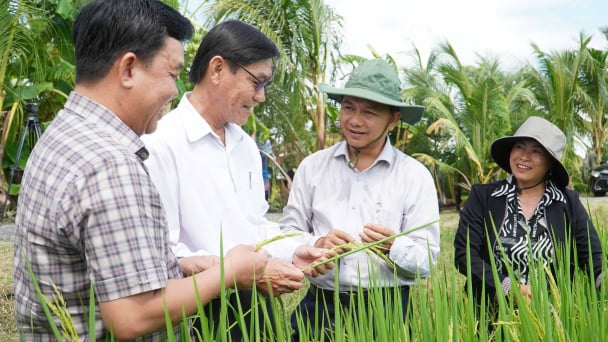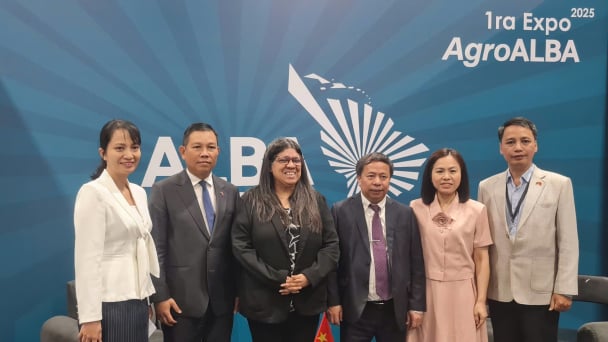June 13, 2025 | 23:17 GMT +7
June 13, 2025 | 23:17 GMT +7
Hotline: 0913.378.918
June 13, 2025 | 23:17 GMT +7
Hotline: 0913.378.918
Tay Son is a midland district of Binh Dinh province with very harsh weather and climate, especially in the hot season. In recent years, due to the influence of climate change, agricultural production in Tay Son district has become increasingly unfavorable due to drought.
In response to climate change, over the past years, Tay Son has increased the area of sesame growing in the province because sesame is a plant with a very good drought tolerance and little need for irrigation water, contributing to the transformation of crop structure on rice land lacking irrigation water and land producing sugarcane and cassava inefficiently.
Currently, Tay Son district has 500 ha of sesame, with an average yield of 9 quintals/ha. This yield has increased compared to previous years but is still low because local farmers use old sesame varieties that have degraded, so their resistance to pests and diseases is poor.
With the above reality, in 2023, Binh Dinh Department of Agriculture and Rural Development directs the Provincial Agricultural Extension Center to coordinate with Tay Son Agricultural Service Center to implement a model of intensive sesame farming on transformed land in order to transfer techniques to farmers. At the same time, evaluate the productivity and economic efficiency when converting from cassava, sugarcane, and green beans to other upland crops in the locality. The model was built in the 2023 summer-autumn crop in Thuong Giang 1 village, Tay Giang commune (Tay Son district), with an area of 2 ha of formerly inefficient rice farming land and the participation of six farmer households.
According to Ms. Vo Nguyen Bich Thuy, technical officer of Binh Dinh Agricultural Extension Center, in Tay Giang commune, rainstorms at the beginning and middle of the 2023 summer-autumn crop and intense heat at the end of the crop affected the growth and development of sesame. However, thanks to the farmers’ consciousness of learning new knowledge and techniques and applying them to practice when participating in the model, sesame in the model gives positive results.

Intensive farming of the sesame variety V36 gave the highest yield ever, reaching 65kg/rod. Photo: V.D.T.
"Currently, in the area of Thuong Giang Agricultural Cooperative, farmers have grown 15ha of sesame. In the past, people used to buy floating varieties, so sesame gave a low yield. When implementing the model of intensive sesame farming on transformed land that was deployed by the Binh Dinh Agricultural Extension Center, we used the sesame variety V36 selected and created by the Agricultural Sciences Institute for Southern Coastal Central of Vietnam. This sesame variety gave the highest yield ever, reaching 65kg/rod (500 m2)", shared Mr. Tran Dinh Tho, Director of Thuong Giang 1 Agricultural Cooperative.
Through actual production, Mr. Tran Dinh Tho noted that the sesame variety V36 has a short growth time of only 75 days. This sesame variety grows and develops stably in dry conditions, with an average tree height of 1.45m and big, green leaves. Sesame fruit has a long shape with four compartments (four segments) and eight rows of seeds. Each leaf eye has 2–4 fruits.
"The factors for the yield of sesame V36 are due to the average number of firm fruits reaching 18 fruits/tree, the number of firm seeds reaching 14 seeds/row, and the weight of 1,000 seeds reaching 2.8 grams. The actual yield is estimated at 13 quintals/ha," said Mr. Tho.
According to Mr. Tho, by monitoring the pest and disease situation on V36 sesame in the model for the 2023 summer-autumn crop, the pests and diseases on V36 sesame are not significant; leaf folders, armyworms, may-bugs, and bugs only cause scattered damage. For diseases, only Rhizoctonia solani and Cercospora sojina diseases occurred, but thanks to farmers' care and timely prevention, they had little effect on yield.

Ms. Vo Nguyen Bich Thuy, technical officer of Binh Dinh Agricultural Extension Center, visited the model of intensive sesame farming on transformed land in Thuong Giang 1 village, Tay Giang commune (Tay Son district, Binh Dinh). Photo: V.D.T.
"The investment cost of growing V36 sesame is more than VND 2.1 million/rod, while for the cassava field, the investment level is more than VND 1.7 million/rod. The yield of sesame is 65 kg/rod, and the current selling price in the field is from VND 45,000 to 48,000/kg. Meanwhile, cassava grown on the same land has a yield of 1,200 kg/rod, but the selling price is only VND 2,100/kg, so the profit of the field in the sesame model is VND 768,000/rod higher than that of cassava growing. The income from the sesame growing model is more than VND 2.3 million/rod, VND 1.5 million/rod higher than that of the cassava field outside the model," said Mr. Tran Dinh Tho, Director of Thuong Giang 1 Agricultural Cooperative.
"The sesame variety V36 is a short-term variety with a growth period of about 75 days in the 2023 summer-autumn crop on Tay Giang land, suitable for arranging a crop rotation structure with 3 crops/year. The variety has good heat tolerance, good pest and disease resistance, and good fall resistance.
On the same land, if a short-term crop rotation is carried out according to the peanut-sesame-maize formula/year, the economic efficiency will be very high. Whereas if only growing cassava, one type of plant can be grown per year, so the production efficiency is low, the soil is quickly degraded, and the pest and disease pressure will be high," said Mr. Tran Dinh Tho, director of Thuong Giang Agricultural Cooperative.

Model of intensive sesame farming on transformed land in Thuong Giang 1 village, Tay Giang commune (Tay Son district, Binh Dinh). Photo: V.D.T.
Translated by Huyen Vu Thu
/2025/06/12/3721-2-202745_83.jpg)
(VAN) TH made an impression at Seoul Food 2025 with its line of natural beverages, paving the way for Vietnamese food products to enter the South Korean market.

(VAN) Soc Trang's success in rice exports stems from a strategy of developing fragrant and specialty rice cultivation areas and standardizing production toward low-emission practices.
/2025/06/11/1311-5-120811_839.jpg)
(VAN) The pig farming industry is facing the challenge of comprehensive restructuring to meet requirements for quality, safety, traceability, and market expansion both domestically and for export.

(VAN) Vietnam considers participating in ALGROALBA in order to expand agricultural production, coordinate the assessment and effective exploitation potential land.
/2025/06/05/5314-1-184727_407.jpg)
(VAN) From seemingly worthless fish scales and skin, enzymes and lactic ferments can transform by-products into peptides, opening a sustainable, effective business direction and elevating Vietnamese seafood.

(VAN) TTC AgriS and IFC signed a strategic partnership to develop a sustainable agricultural value chain, aiming to achieve the Net Zero target by 2035.

(VAN) Seafood by-products are opening a new path, combining green growth and technological innovation to enhance the industry's value.